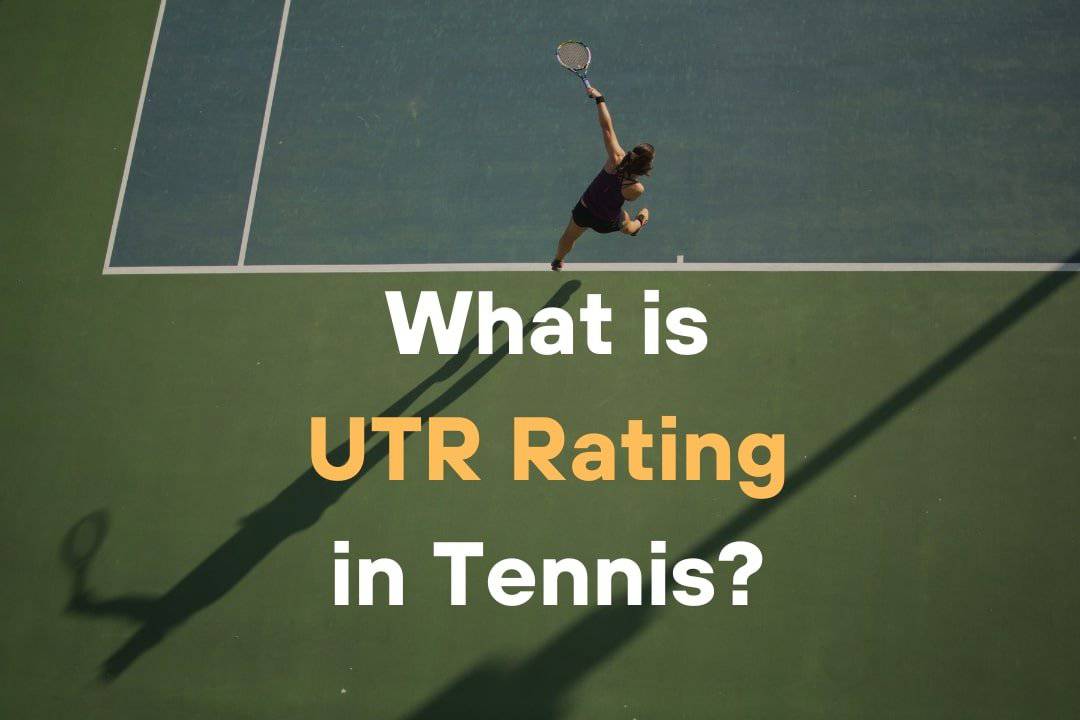To play competitive tennis, you must have a UTR rating. It is required for tournaments, college teams, and many professional tennis events. Also, it can give you benefits for competitive play. So, what is the UTR rating in tennis?
UTR, short for Universal Tennis Ranking, is the global rating system for all tennis players worldwide. UTR rating is scaled between 1.00 and 16.50 no matter the age, gender, or location of the tennis player. The higher the number, the more skilled the player is in tennis.
But what is the UTR rating used for? How do you know that you have a good UTR rating? How do you increase your UTR rating? I will discuss these queries and many more in this article. Keep on reading if you are interested!
Table of Contents
How is UTR Calculated?

UTR is calculated using an algorithm of the player’s last 30 eligible match scores from the previous 12 months. The algorithm calculates UTR ratings based on the players’ match ratings and match weight.
What does match rating and match weight mean?
Match Rating
When you are going to compete against an opponent in a match, the algorithm is going to calculate an expected result of the match.
It is calculated based on the UTR rating difference between the two players and the competitiveness of the games based on the total games won.
This algorithm’s expected outcome will be the factor that decides whether the player’s match rating will go up or down based on the actual outcome.
In other words, your rating will increase if you perform better than the expected outcome. In contrast, your rating will decrease if you perform worse than the expected outcome.
Let’s look at an example:
Let’s say you play an opponent with a higher rating than you. The algorithm will then calculate an expected outcome of you losing the match 6-1, 6-1.
If you lose the match 6-4, 6-4, your rating will go up because you have performed better than the algorithm’s expectations.
Note that you don’t have to win to increase your rating. The important thing is that you need to perform better than the algorithm’s expectation.
Here is a more detailed explanation on how the algorithm works.
Match Weight
All matches, however, are not equal. If you are a 5.00 UTR player, playing against a 6.00 UTR player is not the same as playing against a 7.00 UTR player.
This is where match weight comes in.
To calculate match weight, the higher the UTR rating difference between the two players, the less weight will be calculated.
From the example earlier, a 5.00 UTR player will have more increase/decrease in rating when playing a 4.00 and 6.00 UTR player compared to a 3.00 or 7.00 UTR player.
Other than UTR difference, match weight also considers factors such as the reliability of the UTR rating (players that compete more often have more weight), match format, and time degradation (newer matches get more weight than older matches).
What is a Good UTR Rating?

Is Your UTR Rating Good?
Simply put, the higher your rating, the better your standing. The highest UTR rating a player can get is 16.50.
This level is achieved by only a few players, even amongst the professional scene.
UTR rating of 16.50 shows that the player has an exceptional tennis skills. For context, the highest current UTR rating amongst professional players is 16.46 by Novak Djokovic.
| UTR Rating | Level Comparison |
| 1.00 – 1.99 | Novice Player (Kids) |
| 2.00 – 2.99 | Good Fundamentals (Kids) |
| 3.00 – 3.99 | Entry-Level Female Competitive Player |
| 4.00 – 4.99 | Good Junior Player |
| 5.00 – 5.99 | Entry-Level Male Competitive Player |
| 6.00 – 6.99 | Good Club Male Member |
| 7.00 – 7.99 | Good U.S High School Player |
| 8.00 – 8.99 | Female Collegiate Player |
| 9.00 – 10.99 | Upper-Level Female Collegiate Player |
| 11.00 – 12.99 | U.S. Male Collegiate Player/Female Professionals |
| 13.00 – 15.00 | Upper-Level Division 1 Male Player |
| 15.00 – 16.50 | Male Professional Player |
For professional players, the rating varies, but usually, it will be between 11.00-16.50.
For NCAA Division 1, 12.00-13.00 for males to get a scholarship and 9.00-11.00 for females.
For Club Players, they have a utr rating of 6.00-8.00 for males, 4.00-6.00 for females.
Please note that this is just a general-level comparison.
For example, high school players can also reach a UTR rating of 9.00 or even 11.00. An adult who just started playing tennis may have a UTR rating of 2.00.
See here for a more detailed description of your current level based on your UTR rating.
The Importance of UTR Ratings for Tennis Players

Having a UTR rating is good for several reasons. Naturally, a higher rating will benefit you more than other competing players.
Here are some of the reasons why having a UTR rating is essential for tennis players:
Track Development & Current Level
UTR rating allows players to keep track of their development over time. It can act as a means to get better at the game by achieving a small step-by-step target rating in a specified time.
Small, consistent gains in UTR rating over time will motivate you to get better and better.
It basically is just like leveling up your character in a video game.
It is also a way for people to give a first judgment and know someone’s current tennis skills.
This is an important factor to get decisions on tournament placements, who they play against, fit for a team/camp, college placements, hitting partners, etc.
College Recruitment
UTR rating is the leading standard requirement for college recruitment process. UTR rating is equivalent to SAT scores for academic college applications.
To determine the placement of the player, college coaches must know the player’s current skills based on their UTR rating.
Generally, Division 1 colleges only accept players with a UTR rating of at least 12.
Advantages on Professional Tennis
A player with a higher UTR rating has the advantage of direct entry into tournaments and avoiding qualifying rounds.
This is also why you sometimes see the best players skip the first round and automatically go to the second round instead.
For younger players, having a high UTR rating will give them opportunity to enter major tournaments such as Grand Slam Tournaments to compete with the world’s greatest players.
New emerging young players are usually qualified as a wildcard or have to go through qualifying rounds to compete against the best players.
Ideal Matchmaking
UTR ratings are also used for matchmaking to ensure players face opponents with similar skill levels. This way, it promotes fair and competitive play across the tennis world.
This is a good measurement for newer, younger players to ensure you always play against equally skilled opponents. Hence, you continue to get better over time.
Without a UTR rating, tournaments will have no clue who to pair you with in a match.
How to Find Out Your Tennis UTR Rating?
To see your current UTR rating, you can go to universaltennis.com to set up an account and track your UTR rating progression.
There is also an iOS mobile app available in the United States and Australia. UTR ratings are updated every 24 hours.
On the site, you can see your updated UTR rating and search for other players as well.
How Long Will It Take to Get a UTR Rating?
If you just register for a UTR rating, you can get your rating as fast as you complete your first verified match. However, it will still be a projected rating.
You must have at least five completed matches to get a true rating.
The algorithm is updated every 24 hours. So, updating your UTR rating after finishing a match will usually be reflected in the next day.
What Counts Towards UTR Tennis Tournaments?

Not every tournament count towards your UTR ratings.
The only accounted ones are verified matches including national, international (ITF Juniors, ITF Pros, etc), adult (club-level, open tournaments, etc), and professional (ITF, UTR Pro Tennis Tour, ATP/WTA).
Here is a list of all events that count towards utr rating.
Case Where UTR Rating Does Not Count
UTR rating will not count if you are playing casual matches that is not organized by a verified party or Universal Tennis.
Another example of when UTR rating does not count are when the players have a UTR rating difference of more than 2.00, and the higher player wins as expected.
If the lower rated wins the match, then the result will be counted towards both players’ ratings.
For example, if a player with a UTR rating of 4.20 wins against a 6.50 player, this outcome will count towards both UTR ratings.
However, a 6.50 player winning against a 4.20 player will not count towards UTR ratings.
Last but not least, the instance where a player withdraws before the match starts will also not be counted.
These records will still appear on the player’s profile but are not included in the rating’s calculations.
Best Way to Improve Your UTR Rating

Increasing your UTR rating is pretty straightforward. You just need to keep improving your tennis skills and get more match wins.
Easier said than done, of course, but here are some tips to get better and increase your UTR rating:
Don’t get discouraged even if you lose some matches. The calculation towards the rating is weighted, so if you face higher rating opponents, your rating will not drop as much but will increase significantly if you win.
Participate in more games. The more games you play, the more chance you can get to improve your UTR ratings and tennis experience.
If you already do everything you can at your current level, be patient with the result. With each completed match, whether you win or lose will make you a better overall tennis player.
UTR Rating for Doubles

For doubles, the algorithm calculates the average UTR rating between the two players on each team to determine each side’s UTR rating.
Then, both players on each side will get the same amount of increase or decrease in UTR rating depending on the match’s outcome.
For example, let’s say you are playing doubles with player B, and you have a UTR of 6.00, and player B has a UTR of 5.00. This means that your team has a UTR of 5.50.
Then, the other team will also have the average UTR of the two players.
Match rating will then be calculated based on the two teams’ UTR difference.
UTR Rating of Professional Players (Rafael Nadal, Naomi Osaka, Novak Djokovic, Roger Federer, Emma Raducanu, Serena Williams, etc)

Once you get to a certain level, you may want to compare your UTR rating with the best professional players in tennis.
Or maybe you just simply curious.
The table below shows the UTR ratings of some famous professional tennis players (as of the time of this writing):
| Name | UTR Rating |
| Rafael Nadal | 16.18 |
| Novak Djokovic | 16.46 |
| Roger Federer | 15.58 |
| Naomi Osaka | 12.12 |
| Emma Raducanu | 12.33 |
| Serena Williams | 12.88 |
| Andy Murray | 15.81 |
| Carlos Alcaraz | 16.34 |
If you don’t see your player here, you can search for them easily from here.
History of UTR in Tennis
The UTR rating system was first introduced in 2008 by Virginia Tennis Pro Dave Howell. The algorithm was designed by Alex Cancado.
Over time, the UTR ratings became more popular and used all over the world, including major professional players such as Rafael Nadal and Novak Djokovic.
UTR vs. NTRP Rating
NTRP ratings are used within the USTA league structure to rate tennis players’ levels.
Unlike UTR ratings being updated based on algorithms from recent game results performance, NTRP ratings are self-assessed and revised annually.
So, if you have a UTR rating, can you convert it to NTRP or vice versa?
There is no official comparison between UTR ratings and NTRP. Still, there are some approximate conversions to compare the two ratings.
For example, this is a conversion table published by the USTA (usta.com)
| Men’s NTRP | UTR Range | Women’s NTRP | UTR Range |
| 4.0 | 6 – 8 | 4.0 | 4 – 6 |
| 4.5 | 8 – 10 | 4.5 | 6 – 8 |
| 5.0 | 10 – 12 | 5.0 | 8 – 10 |
| 5.5+ | 11+ | 5.5+ | 9+ |
Or you can use this NTRP to UTR Conversion Formula (used by Tennis360):
(Men’s NTRP) x 2.2 = UTR
(Women’s NTRP – 0.5) x 2.2 = UTR
As mentioned, this number is just an approximation.
Learn more about other tennis levels here.
Wrapping Up
This article discusses all you need to know about UTR ratings. UTR or Universal Tennis Rating is important to have if you plan to advance competitively in your tennis career.
No matter what your age, location or gender, anyone can apply for UTR ratings, and you can start being rated from 1.00 or 16.50 as a tennis player.
Remember to believe in your skills and have fun. The more matches you play, the quicker your UTR and skill level will improve!
Related Questions
What does a UTR of 4 mean? Is it Good?
A UTR of 4 is usually equivalent to a solid junior player. They have good fundamentals and are starting to be able to volley and hit overheads consistently, but not yet perfectly. What they lack of is usually a consistent power and decisiveness to their shots.
What does a UTR of 6 mean? Is it Good?
A UTR of 6 is usually equivalent to a solid male club player. The players generally have a lot of variety in their games. They are familiar with good strokes and spins. They usually lack tactical strategy and experience, such as the mental and confidence aspect of the game.
Do UTR Ratings Fluctuate Over Time?
Yes, the UTR rating is constantly updated with every new match that the player plays. More wins will increase the rating, and losses may cause a decline. If you don’t play more matches, your UTR ratings can also change because it only takes account the most recent 30 matches of the last 12 months.
Can Recreational Players Have UTR Ratings?
Yes, the UTR rating is not only exclusive to professional and competitive players. Recreational players can also create profiles to track and improve their UTR ratings by completing verified matches on the universal tennis site.
Can Adults Apply for Tennis UTR?
Yes, adults can also apply for Tennis UTR and develop their UTR ratings just like juniors and all other tennis players of different ages.
Can You Still Get UTR Rating If You Don’t Play Often?
Yes, one match is the minimum requirement to get a UTR ‘projected’ (P) rating. The algorithm calculates up to the most recent 30 matches. That is the maximum, but technically there is no minimum. However, if you want your rating to change from projected to reliable, you will need to play approximately 5 matches within the last 12 months.


2 thoughts on “What Does UTR Rating Means in Tennis? – All You Need to Know”
Comments are closed.